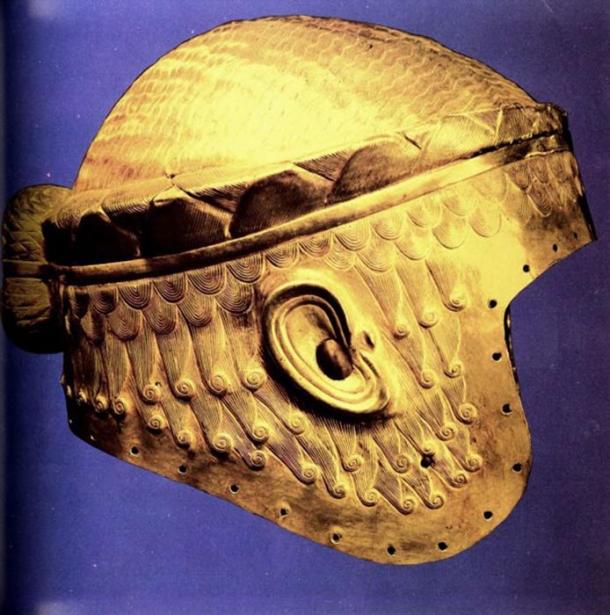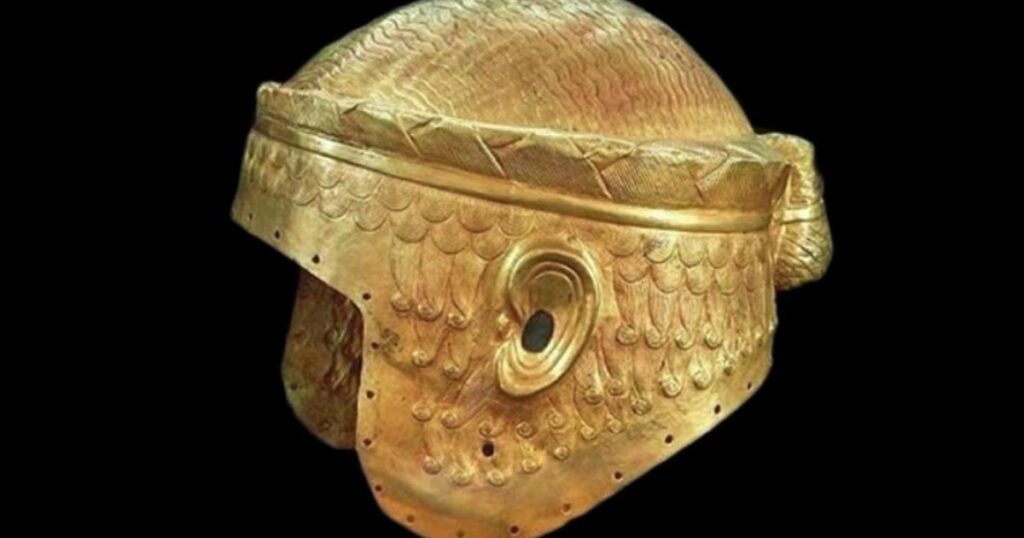The war helmet of Meskalamdug is an artifact that was discovered in one of the graves in the Royal Cemetery at Ur. This grave was found to have belonged to an ensi (roughly translated as ‘ruler’) of Ur by the name of Meskalamdug. Based on an inscription on a lapis lazuli bead discovered in the ancient city of Mari, Meskalamdug was a King of Kish, a title said to have been held by one who ruled over both Sumer and Akkad. Nevertheless, there had been two rulers by the name of Meskalamdug, one being the grandfather of the other, and it is unclear if the owner of the war helmet was the older or younger Meskalamdug.
Discovery of the Grave

The grave of Meskalamdug was discovered in 1924 by the renowned British archaeologist Leonard Woolley. This grave was initially named as PG 755 (PG being an acronym for ‘Private Grave’). Within the grave, Woolley discovered a skeleton that was buried with numerous grave goods. Based on analyses of the bones, the skeleton belonged to a man who was probably under 30 years of age at the time of death. The man was of a strong build and was around 1.7 m (5.5 ft.) in height.
Grave Goods and Inscriptions
As the archaeological evidence suggests, the deceased was buried with a large amount of grave goods, including simple household vessels, weapons, tools, and personal ornaments. Amongst these objects were one copper and three gold vessels which had the name ‘Meskalamdug’, though without a title, inscribed on them. It was from these inscriptions that the owner of the grave was identified. Although a seal is said to have been found on the belt of the man buried in PG 755, it was too damaged to be deciphered.

As mentioned earlier, an inscription on a lapis lazuli bead from Mari indicates that there had been a king by the name of Meskalamdug. Additionally, such inscriptions have also been found in several of the other graves in the Royal Cemetery at Ur. For example, RT. (Royal Tomb) 1054 once had a wooden box, which had rotted away prior to the tomb’s discovery by Woolley. Whilst the box no longer exists, its contents, two gold daggers, and a seal were found. It was established that the seal was inscribed for a man by the name of Meskalamdug, who held the title lugal, or ‘king’. Some have suggested that the Meskalamdug in PG. 755 and the one mentioned on inscriptions outside that grave are two different individuals, with the former being a less illustrious grandson of the latter.
The Gold Helmet

Apart from inscriptions, another object that may help to determine the identity of the person buried in PG. 755 is the gold helmet that was found in the grave. The helmet was made to look like its wearer’s own hair. Details that can be seen on this piece of headdress include a knotted bun at the back, a woven band on the top, and ears on the sides. At the bottom of the helmet are small holes, which are believed to have held a piece of cloth that lined the inside of this object.
Significance and Status
Being made of gold, it has been commonly thought that the owner of the helmet had royal status. It has been argued, however, that instead of just being a royal, the helmet’s owner was the King of Kish, the ruler of both Sumer and Akkad. It has been pointed out that two other figures who wore such a helmet were Sargon the Great and Eannatum. As both these men are said to have held the title of ‘King of Kish’, experts suggest that this type of helmet was used exclusively by the kings of Kish. Based on this line of reasoning, the person buried in PG. 755 is indeed the Meskalamdug that was mentioned in the inscriptions found in locations outside his tomb.
The war helmet of Meskalamdug stands as a testament to the power and influence of the early rulers of Mesopotamia, providing invaluable insights into the culture and politics of one of the world’s earliest civilizations.

